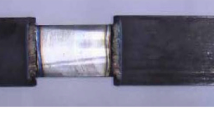Abstract
Ductility-dip cracking (DDC) in the heat-affected zone (HAZ) of NiCr15Fe-type alloys was studied using the programmable-deformation-crack (PVR) and the strain-to-fracture (STF) test. This paper concentrates on the cracking morphology and the effect of metallurgical factors for DDC susceptibility. The obtained results are discussed in the context of the underlying cracking mechanism. Evidence was found that DDC in the heat-affected base metal occurs due to a relative grain boundary movement, which induces high strain buildup at grain boundary triple points, subsequent cavity formation, and intergranular crack propagation. Base metal grain size and intergranular carbide precipitation are shown to have a significant effect on DDC susceptibility and are discussed in the context of the observed grain boundary sliding mechanism.

















Similar content being viewed by others
References
Wolf M (2006) Zur Phänomenologie der Heißrissbildung beim Schweißen und Entwicklung aussagekräftiger Prüfverfahren. Helmut-Schmidt-Universität/Universität der Bundeswehr Hamburg, Dissertation (in German)
Ramirez AJ, Lippold JC (2004) High temperature behavior of Ni-base weld metal—part II. Mater Sci Eng A 380(1–2):245–258
Noecker F II, DuPont JN (2009) “Metallurgical investigation into ductility dip cracking in Ni-based alloys: part II”. Weld J 88(3):62s–77s
Young GA, Capobianco TE, Penik MA (2008) The mechanism of ductility dip cracking in nickel-chromium alloys. Weld J 87(2):31s–43s
Zheng L, Schmitz G, Meng Y, Chellali R, Schlesiger R (2012) Mechanism of intermediate temperature embrittlement of Ni and Ni-based superalloys. Crit Rev Solid State Mater Sci 37(3):181–214
Nishimoto K, Saida K, Kiuchi K, Nakayama J (2011) Influence of minor and impurity elements on hot cracking susceptibility of extra high-purity type 310 stainless steels. In: Böllinghaus T, Lippold J, Cross CE (eds) Hot Cracking Phenomena in Welds III. Springer, Berlin, pp 183–208
Matsuda F, Nakagawa H, Minehisa S, Sakabata N, Ejima A, Nohara K (1984) Weldability of Fe-36% Ni alloy (report II). Effect of chemical composition on reheated hot cracking in weld metal. Trans JWRI 13(2):69–75
Lippold JC (2015) Welding Metallurgy and Weldability. Hoboken, Wiley
Collins MG, Lippold JC (2003) An investigation of ductility dip cracking in nickel-based filler materials—part I. Weld J 82(10):288s–295s
Ramirez AJ, Sowards JW, Lippold JC (2006) Improving the ductility-dip cracking resistance of Ni-base alloys. J Mater Process Technol 179(1–3):212–218
Tatman J, McCracken S (2014) “Update on 52 Weldability—Comparison of Ductility-Dip Cracking in a Narrow Groove Weld to Strain Accumulation Determined by Computer Simulation,” Presented at the Industry/U.S. NRC Materials Program Technical Information Exchange Meeting, Rockville
“ISO/TR 17641–3:2005—Destructive tests on welds in metallic materials—hot cracking tests for weldments—arc welding processes—part 3: externally loaded tests.” 2005
F. Matsuda, “Hot crack susceptibility of weld metal,” in Proceedings from the First United States-Japan Symposium on Advances in Welding Metallurgy, San Francisco, CA (USA)/Yokohama (Japan), 1990, pp. 19–36
J. M. Kikel and D. M. Parker, “Ductility dip cracking susceptibility of Inconel Filler Metal 52 and Inconel Alloy 690,” in Trends in welding research. Proceedings of the 5th International Conference, Pine Mountain, GA (USA), 1998, pp. 757–762
Nissley NE, Lippold J (2003) Development of the strain-to-fracture test. Weld J 82(12):355s–364s
Alexandrov BT, Hope AT, Sowards JW, Lippold JC, McCracken S (2011) Weldability studies of high-Cr, Ni-base filler metals for power generation applications. Weld World 55(3–4):65–76
Kiser SD, Baker BA, Zhang R (2008) A new welding material for improved resistance to ductility dip cracking. In: Trends in Welding Research. Proceedings of the 8th International Conference, Pine Mountain, pp 639–644
Fink C, Zinke M, Keil D (2013) Evaluation of hot cracking susceptibility of nickel-based alloys by the PVR test. Weld World 56(7–8):37–43
C. Fink, M. Zinke, and S. Jüttner, “An investigation of ductility-dip cracking in the base metal heat-affected zone of wrought nickel base alloys—part II: Correlation of PVR and STF results,” Weld. World, May 2016
Chen JQ, Lu H, Cui W, Chen JM, Huang YF (2014) Effect of grain boundary behaviour on ductility dip cracking mechanism. Mater Sci Technol 30(10):1189–1196
Torres EA, Caram R, Ramirez AJ (2010) Grain boundary sliding phenomenon and its effect on high temperature ductility of Ni-base alloys. Mater Sci Forum 638–642:2858–2863
Noecker F II (2007) Metallurgical Investigation into Ductility Dip Cracking in Ni Based Alloys. Dissertation, Lehigh University
Zhang Y-C, Nakagawa H, Matsuda F (1985) Weldability of Fe-36%Ni alloy (report III). Dynamic observation of reheat hot crack and evaluation of hot ductility of reheated weld metal (materials, metallurgy & weldability). Trans JWRI 14(1):107–114
Rhines FN, Wray PJ (1961) Investigation of the intermediate temperature ductility minimum in metals. Trans ASM 54(2):117–128
Hemsworth B, Boniszewski T, Eaton NF (1969) Classification and definition of high temperature welding cracks in alloys. Met Constr Brit Weld J 16(1):5–16
Singh I, Kroenke W, Cola M (1997) “Analytical Prediction of the Location of Ductility Dip Cracking in the Trans-Varestraint Test”, Bettis Atomic Power Laboratory, West Muffin (PA), USA, WAPD-T-3135
Acknowledgments
The author would like to acknowledge the advice and ongoing support of Dr. Manuela Zinke and Prof. Dr.-Ing. Sven Jüttner, both at the Institute of Materials and Joining Technology, Otto-von-Guericke-University Magdeburg, Germany. Further, the author would like to thank Dr. Martin Wolf and Dr. Jutta Klöwer, both with VDM Metals GmbH, for their material donations and their continuing interest in this work.
Author information
Authors and Affiliations
Corresponding author
Additional information
Recommended for publication by Commission II - Arc Welding and Filler Metals
Rights and permissions
About this article
Cite this article
Fink, C. An investigation on ductility-dip cracking in the base metal heat-affected zone of wrought nickel base alloys—part I: metallurgical effects and cracking mechanism. Weld World 60, 939–950 (2016). https://doi.org/10.1007/s40194-016-0370-4
Received:
Accepted:
Published:
Issue Date:
DOI: https://doi.org/10.1007/s40194-016-0370-4




